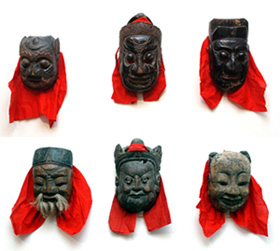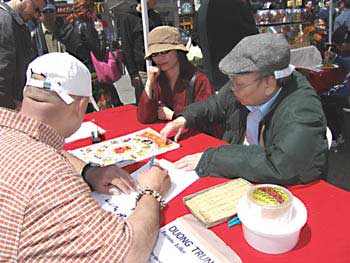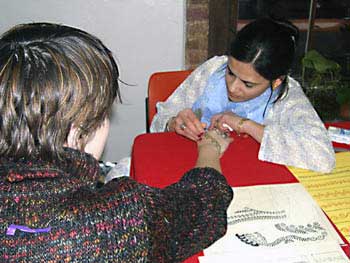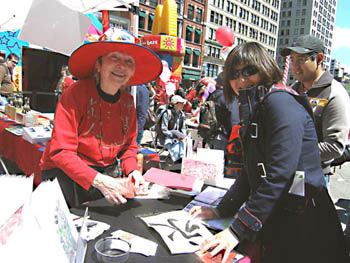 |
Exhibitions | Education | Traditional
Arts | Internship | Publications
TRADITIONAL ARTS

Nuo,
The Forgotten Folk Art
What is Nuo?
Nuo is a
form of Chinese masked drama enacted by a priest or specially
trained shamans as a means of exorcism; it is also a theatrical
performance with a
presentational aspect, and festival, with the idea of gathering to
establish
ties and norms between heaven and earth, life and death, man and gods,
the ruler
and his subjects, a very prominent Chinese cosmological concept.
The Nuo rituals have been deeply incorporated into Chinese living. It has
also spread widely among people of various ethnicities throughout the
ages. One can see many of the similarities to shamanistic practice that knowing
the spirit world requires masks, dancing, motion, and theatrical or
ceremonial set-up. Considered "spiritual tutors", professional Nuo performers
are believed to be capable of wielding magic power to disperse evil
demons, spirits, and pestilence. Besides training in ritual procedures and
exorcism, the performers also have to be adept in the Nuo opera. The whole ritual
procedure includes inviting, welcoming, and thanking spirits. Following
the solemn ritual, the Nuo opera will be performed to entertain the spirits. And
according to the Chinese folklore, a street parade of legendary generals and deities
could best expel evil from the community. Nuo performers at the performing
hall or in procession are often equipped with whips and dance in mysterious
tunes. They also wear masks painted with black, white and red in various
countenances -- some amiable and others ferocious and frightening.
Stylistic features and characteristic of the masks vary widely and reveal much about the
regions, cultures, and civilizations from which they come. Guizhou and Jiangxi area
is famous for the greatest varieties of Nuo opera. Wherever there is a Nuo
opera performance in an outlying village, farmers in surrounding villages will
trek dozens of kilometers of hillside path to watch. Though some elderly folks
still have awe and reverence for the Nuo dancing "gods", fewer now are
familiar with the content and expertise of the ritual.
But with the passage of time and increasing popularization of
scientific
knowledge, the primitive superstitious ritual has now been transformed
into a
theatrical performance for entertainment and a genre of folk art.
Formerly, the
ritual gives expression to the uncertainty of early peoples towards the
unknown
world and universe, but nowadays the most fascinating part is the vivid
Nuo
opera that follows. The opera itself contains long-standing knowledge
about
religion, society and ethnic groups in the early stages of human
society and
provides an important reference for the in-depth study of music, dance
and
painting as well as other arts. Nuo ritual, considered to be one of the
oldest
forms of Chinese dancing, is not only a theatrical performance for
entertainment
in modern society, it is also a matrix of the Chinese arts. From these
magical-looking facial coverings, the spectators can theorize on the
mythology, art
and ancestral view of their creators. The Nuo masks, as the major
vehicles in
the ritual to transmit gods’ power and benevolence to man,
bear a potent,
vivid testament of its link with Chinese ancient culture and its folk
arts.
The origins
and historical background of the Nuo mask ritual
In ancient
China, there is a form of dance called Nuo. The Nuo ritual
has
been practiced in China for thousands of years from the primitive times
when
early men performed sacrifices and conducted ceremonial services to pay
tribute
to ancestors, gods, and goddesses while exorcising demons. Dancers used
masks
to perform at ritual ceremonies to frighten off the ghosts and evil
spirits
and to relieve people of epidemics. The origins of Nuo culture in
Zhejiang
province are one of the most ancient and can be traced back over four
thousand
years to the Liangzhu culture of the neolithic period. In
Liangzhu’s ancient
sites in Yuhang county large numbers of engraved Taotiedesigns on jade
have been
discovered and are considered the most ancient and the only source of
the
designs on Nuo masks. Major Nuo rituals in the courts were documented
in the
classic "The Book of Rites" which mentioned "the golden four eyes", a
reference to
the metallic masks performing in the Nuo ritual. Today the Nuo
exorcising
ritual is best known to be carried on yearly in an outlying villages of
ethnic
Tujia people at the base of Fanjing Mountain and in southwest China's
Guizhou
and Jiangxi provinces.
In some districts, the Nuo ritualistic dance later developed into a
theatrical and formal performance. A story relates that during the
North Qi Period
(550-557), Lanling King was too handsome to terrorize the enemy even
though he
was excelled in martial arts. He began to wear a ferocious-looking mask
on the
battlefields in order to overwhelm the enemy. This story was later
brought
onto the stage in South-North (420-589) and Sui-Tang dynasties
(618-907), which
is known as "The Lanling King" The masks used by the performers in
ritual
ceremonies and in the performing art had a strong bearing on the
origination of
the facial make-up in the Chinese operatic performances. In Tang
dynasty,
masks still were used in low comedy, but started to dye the masks in
portrayal of
super-human beings. In Ming dynasty (1318-1644), roles among actors
divided
into more classifications, and operas and facial make-up were gradually
standardized. During the Qing time, with the rise of Peking opera, the
art of facial
make-up became increasingly perfected. Toward the end of Qing dynasty,
the
facial make-up became finalized. It is also believed that the Nuo mask
has its
direct historical and stylistic connection with other foreign mask
rituals in
Japan, Korea, Taiwan, Thailand, Nepal, India, Tibet, and Mongolia as
well as
Sri Lanka.
Nuo ritual, dances, and plays have always flourished in the Chinese
cultural
areas, right up to the present day, and in olden times performances
took place
virtually every month. It later spread widely among people of various
ethnicities in the Yangze River valley, the Yellow River valley, and
also the
secluded southwestern region. It is important to note that while
Sichuan, the
believed birth place of Chinese Nuo dance, is in the northern cultural
zone, it is
in the southern religious and spiritual centers that Nuo culture
continues to
exist and be preserved until today.
This article is researched and authored by
Robert Lee, Executive Director & Curator
Ling-Yi Chien, Art & Education Consultant
Asian American Arts Centre

|
back to top
Asian American Arts Centre Presents: Lunar New Year Folk Arts Festival 2008
Date: Sunday, February 10th, 2008 from 3:00 - 5:30 p.m.
To celebrate the Lunar New Year, the Arts Centre is pleased to
announce "A Lunar New Year Folk Arts Festival" featuring Chinese, and
Mongolian Folk Artists. Five traditional artists/crafts people will be
giving hands on demonstrations. Artists include a Chinese miniature
dough figurine artist, a Sumi ink calligrapher, an Indian Mahendi hand
painting artist, an Er Hu performer, together with Chinese and
Mongolian folk dance performance. New Year delicacies will also be
served.
Audiences will have the opportunity to interact with skilled folk
artists who demonstrate their crafts and will have the opportunity to
ask questions, make requests and the chance to learn and delight in
the magic of a traditional craft and to enjoy traditional folk dance.
This is an ideal event for families. The music, art and performances
will delight both old and young alike.
Festival Admission: $12 - General; $6 - Senior Citizens, Students;
Children 3 - 12 - $6: and for Children 3 and under - Free.
Come early. Space is limited. For reservation and information write
to aaacinfo@artspiral.org or call (212) 233-2154.
The Festival Artists
Kavita Vyas practices the Art of Mehandi, the art of painting designs
on hands and feet. Mehandi designs use animals and floral patterns,
sometimes even musical instruments, taking hours to finish. It began
over 100 years ago in India by the Muslims, mostly in Pakistan. It is
also widely done by the Arab people. She learned this art form from
the master Mrs. Saroj Oza, who created the cone method. Kavita loves
Mehandi art because she can create new designs each time she paints.
Kavita and her Mehandi art was covered on the 10 o'clock news, Channel
11.
Kwok Kay Choey was born in Singapore and learned to play the Er Hu as
a teenager with Wu Gong-xi. Since 1964, he has been a resident member
of the New York Chinese Music Ensemble and has performed in its
bi-annual season each year in New York City as well as performing in
the tri-state area. He is also a painter, calligrapher and Tai Chi
master.
Ye Xun, born in Zhejiang, has combined the qualities of both his
master teachers, the poetic sensibility of Master Zhao Kou Ming with
the realistic representation of color and manner of Master Lang Shao
An (his grandfather). His figures appear life-like with a sense of
vitality in the scenes and characters of his work. His work includes
the famous mythological characters such as the Monkey King from
"Journey to the West", the Eight Immortals and the Goddess of Mercy.
He has also won numerous awards for his designs including First Place
in the Zhejiang Provincial Competition for Best Design.
Rose Sigal-Ibsen has practiced calligraphy for many years and won
critical acclaim for her work. Born in Romania and migrating from
Israel to the US, she worked as an enamelist after studying at FIT.
In 1979 she began her study of Sumi ink at the KoHo School of Sumi-e
in NY and later Chinese brushwork at the Zhejiang Academy in China.
She has won Awards of Excellence from the Kampo Cultural Center and
from the Manhattan Arts International magazine. She has exhibited
widely, for example, in China at the Fourth World Conference on Women
in Beijing, in Bucharest at the Romanian Cultural Foundation, and in
the US at the Steinhardt Conservatory and the National Museum of Women
in the Arts in Washington DC.
In addition, an exhibition of Chinese Tribal Textiles from the
Minority Peoples of China will be on view during this festival,
through February 29, 2008. These are museum quality richly woven and
traditionally batik dyed and embroidered textiles representative of
historical tribal traditions. They are from the peoples known as:
Miao, Gejia,Yao, Yi, Dai, Li, and Zhang. Many garments, banners,
festival jackets and blankets fill the gallery, and some are quite
fashionable for use today.




back to top
|











